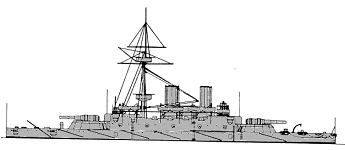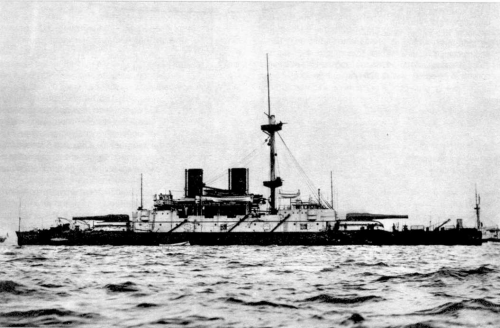

Benbow 1889
|
Name |
No |
Yard No |
Builder |
Laid down |
Launched |
Comp |
Fate |
| Benbow | 21h | Thames Iron Wks, Blackwall | 1.11.1882 | 15.6.1885 | 6.1888 | sold to BU 13.7.1909 |
Displacement normal, t |
10600 |
Displacement full, t |
|
Length, m |
100.6 pp |
Breadth, m |
20.9 |
Draught, m |
8.48 |
No of shafts |
2 |
Machinery |
2 3-cyl IVC, 12 cylindrical boilers |
Power, h. p. |
10860 |
Max speed, kts |
17.5 |
Fuel, t |
coal 1200 |
|
Endurance, nm(kts) |
7100(10) |
|
Armour, mm |
compound; belt: 457 - 203 with 178mm wood backing, bulkheads: 406 - 178, barbettes: 356 - 305, decks: 76 - 64, CT: 305 - 51 |
Armament |
2 x 1 - 413/30 BL Mk I, 10 x 1 - 152/26 BL Mk IV/VI, 12 x 1 - 57/40 6pdr Hotchkiss Mk I, 7 x 1 - 47/40 3pdr Hotchkiss Mk I, 5 - 356 TT (1 bow, 4 beam) |
Complement |
523 |
Project history: Last representative of 'Admiral' class had 413mm 110t guns instead of the 343mm on earlier ships. Weight considerations meant that only one gun could be mounted in each barbette but the margin of weight thus obtained allowed for an additional 4 152mm guns in the secondary battery. In other respects she was virtually identical to Anson and Camperdown. 413mm guns were not chosen for their power but because of the limited manufacturing capacity for the 343mm Woolwich guns. 413mm guns were manufactured by Armstrong to its own design, they were not entirely successful as they were slow-firing, of limited life and tended to 'droop'.
Benbow was delivered from the builders in 1886 but did not commissioned until 1888.
Ship protection: Ships had fixed, pear-shaped barbettes 15.3m long and 13.7m wide, each having 356mm sloping sides, 305mm rear and 76mm floor giving protection to turntable, crew, training and loading gear. The top of the barbette was covered with bullet-proof plating. A trunk of 305-254mm thickness, between the rear of the barbette and the top of the citadel, protected the ammunition supply. On account of weight considerations, and because the citadel was reduced to 457mm belt, 45.8m long by 2.3m deep, closed at the ends by 406mm bulkheads and covered by 76mm deck. The belt extended to 1.5m below the waterline and tapered over the lower 1.1m to 203mm at the lower edge, bulkheads being 178mm at the lower edge. The lower deck was 64mm thick outside the citadel, the area between this and main deck being extensively subdivided and employed for coal bunkers and stores. The coal stowage inside and outside the citadel was arranged to provide additional protection, but cork compartments were not included, although the ship was fitted with anti-rolling tanks. 152mm guns were unprotected except for splinter plating and 152mm armour screens at the ends of the superstructure as a defence against raking fire.
Modernizations: 1896-1897: - 10 x 1 - 152/26; + 10 x 1 - 152/27 QFC Mk I/IV / I/VI / II/IV / II/VI / III/IV / III/VI
Naval service: Benbow served as coastguard ship in 1894-1904. She spent majority of her career in reserve and sold for BU 13.7.1909.
Many thanks for Borys Estrin for additional information.

Benbow
© Ivan Gogin, 2008-14